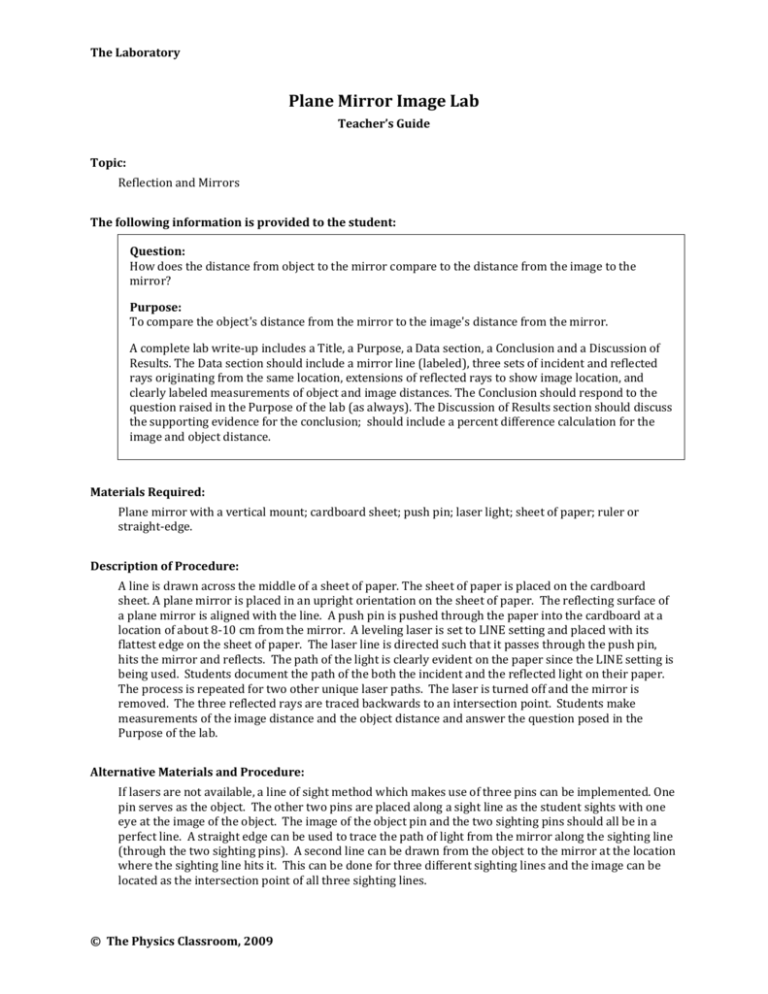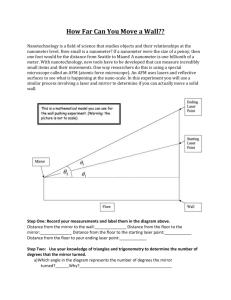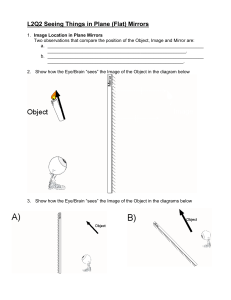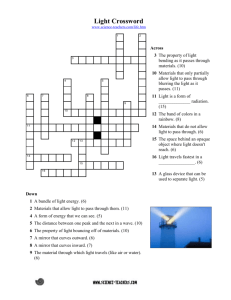Plane Mirror Image Lab - The Physics Classroom
advertisement

The Laboratory Plane Mirror Image Lab Teacher’s Guide Topic: Reflection and Mirrors The following information is provided to the student: Question: How does the distance from object to the mirror compare to the distance from the image to the mirror? Purpose: To compare the object's distance from the mirror to the image's distance from the mirror. A complete lab write-up includes a Title, a Purpose, a Data section, a Conclusion and a Discussion of Results. The Data section should include a mirror line (labeled), three sets of incident and reflected rays originating from the same location, extensions of reflected rays to show image location, and clearly labeled measurements of object and image distances. The Conclusion should respond to the question raised in the Purpose of the lab (as always). The Discussion of Results section should discuss the supporting evidence for the conclusion; should include a percent difference calculation for the image and object distance. Materials Required: Plane mirror with a vertical mount; cardboard sheet; push pin; laser light; sheet of paper; ruler or straight-edge. Description of Procedure: A line is drawn across the middle of a sheet of paper. The sheet of paper is placed on the cardboard sheet. A plane mirror is placed in an upright orientation on the sheet of paper. The reflecting surface of a plane mirror is aligned with the line. A push pin is pushed through the paper into the cardboard at a location of about 8-10 cm from the mirror. A leveling laser is set to LINE setting and placed with its flattest edge on the sheet of paper. The laser line is directed such that it passes through the push pin, hits the mirror and reflects. The path of the light is clearly evident on the paper since the LINE setting is being used. Students document the path of the both the incident and the reflected light on their paper. The process is repeated for two other unique laser paths. The laser is turned off and the mirror is removed. The three reflected rays are traced backwards to an intersection point. Students make measurements of the image distance and the object distance and answer the question posed in the Purpose of the lab. Alternative Materials and Procedure: If lasers are not available, a line of sight method which makes use of three pins can be implemented. One pin serves as the object. The other two pins are placed along a sight line as the student sights with one eye at the image of the object. The image of the object pin and the two sighting pins should all be in a perfect line. A straight edge can be used to trace the path of light from the mirror along the sighting line (through the two sighting pins). A second line can be drawn from the object to the mirror at the location where the sighting line hits it. This can be done for three different sighting lines and the image can be located as the intersection point of all three sighting lines. © The Physics Classroom, 2009 The Laboratory Safety Concern: There is always a higher than usual level of risk associated with working in a science lab. Teachers should be aware of this and take the necessary precautions to insure that the working environment is as safe as possible. Light from lasers should never be pointed into a person's eye. Caution should be taken to avoid such mishaps. Student horseplay and off-task behaviors should not be tolerated. Suggestions, Precautions, Notes: 1. 2. 3. 4. 5. 6. Here are two methods for vertically mounting a plane mirror so that it stands upright on a sheet of paper. First, 1-inch thick strips of wood with the same dimensions as the mirrors can be cut and glued to the back of the mirrors. The wood must be perfectly flat along one of its edges. Second, large binder clips could be purchased and clipped to the bottom sides of your mirrors to provide a base of support. Inexpensive leveling lasers can be purchased at a home store. They often go on sale for $5 during the Christmas season. They possess the capability of projecting the laser as a line or a beam. If the price is right, consider picking up a class set for use in both reflection and refraction activities. Most inexpensive mirrors are coated with a reflective material on the back surface of a thin pane of glass. This does cause difficulties for many optics labs since the reflecting surface is actually behind the glass and not on the glass. A quick fix is to use a so-called two-way mirror which has its reflective coating on the front of the glass (actually, on both sides of the acrylic). An acrylic sheet can be purchased and cut into 3"x5" strips for a cost of approximately $2 per mirror. Avoid scratching the mirror during the cutting process. This lab represents a great opportunity to begin reinforcing the concept of an image location as the location in space where it seems to every observer that reflected light is coming from. For this lab, that location is the location where all the reflected rays intersect when traced back behind the mirror. This lab represents a great opportunity to pool class results. After completing their procedure and measurements, request that students come forward and write their group's do and di values on the board. With several data points, a suitable conclusion can be drawn. Warn students in advance of the lab of the need to never direct laser light at another person's eye. Students who do not heed your warning should immediately be dismissed from the lab. Auxiliary Materials: None Scoring Rubric: RM2. Rough versus Smooth Lab Included, labeled and organized all parts of the lab report. Data section includes a wealth of observations pertaining to reflection of light off a mirror, dry paper and wet paper (diagrams would be useful); observations are labeled to distinguish between the surfaces observed; observations are clear, pertinent and understandable. Conclusion/Discussion describes the differences in reflection off the three types of surfaces. An accurate, reasonable and thorough explanation of the differences is provided. Connections to The Physics Classroom Tutorial: The following reading is a suitable accompaniment to this lab: http://www.physicsclassroom.com/Class/refln/u13l2a.cfm © The Physics Classroom, 2009 Score _____/_____ The Laboratory http://www.physicsclassroom.com/Class/refln/u13l2b.cfm Connections to Minds on Physics Internet Modules: Sublevels 2 and 3 of the Reflection and Mirrors module are suitable accompaniments to this lab: http://www.physicsclassroom.com/mop/module.cfm © The Physics Classroom, 2009







